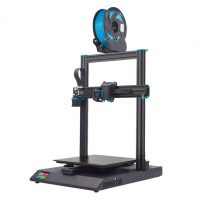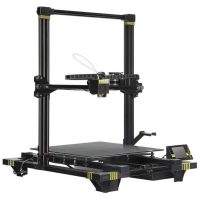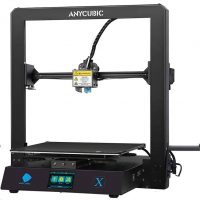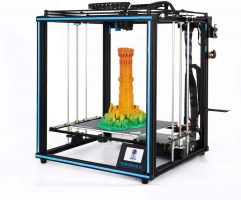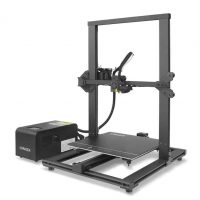Best Large 3D Printer in 2021
The best supersized 3D printers
- Last Updated Jun 21, 2021
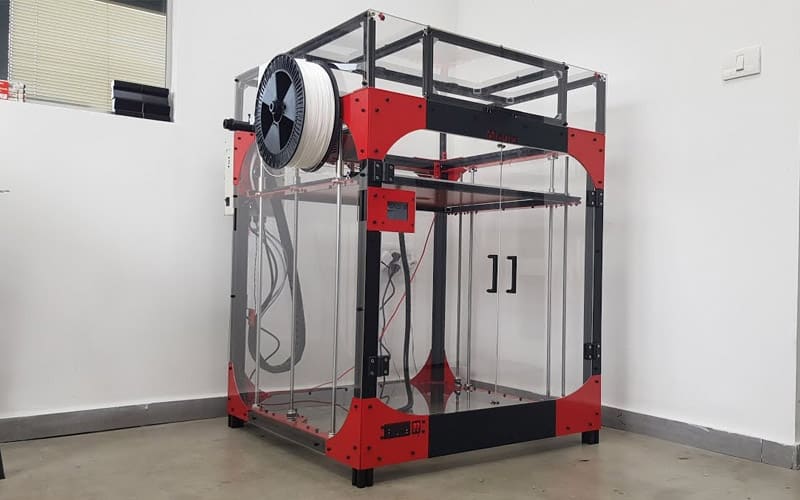
A 3D printer capable of churning out large-scale objects isn’t an attribute found in every model on the market, and until not long ago, it was very much limited to industrial-grade rigs. Fortunately, large object printing no longer sits behind a hefty price tag as more and more affordable printers with generously sized build volume hit the market each year.
As specifications go, a large build volume is among the most versatile additions to any 3D printer’s toolkit, whether that’s for enthusiastic home tinkerers eying up more ambitious designs or a small business prototyping their latest flagship product.
With build volumes that put to shame the usual form factor of hobbyist printers, these supersized printers can confidently produce models or churn out multiple objects at a time to turn even a modest setup into a conveyor belt 3D printing powerhouse.
Much like standard 3D printers, wading through what’s out there and making an informed choice can be taxing. With that in mind, we’ve pulled together a selection of top recommendations for those in the market for one of the best large 3D printers currently out there.
Products at a Glance
How We Picked
Naturally, a super-sized build volume is the main attribute we looked for when leafing through the spread of large 3D printers. More common 3D printer criteria, such as construction, components, print speed, print quality, ease of use, assembly process, material compatibility, and features like a heated bed, connectivity, auto bed leveling, filament sensor, and outage recovery, also helped us sort the good from the bad.
After careful consideration, we shrunk down our choices to five large 3D printers. With any one of these, you are more or less guaranteed a satisfying printing experience. Below, we’ve pieced together a brief review of each, pinpointing the strengths and weaknesses of each option. In addition, you’ll find a ‘Things To consider’ section at the end with a few top tips to remember when shopping for a large 3D printer.
Best Large 3D Printer in 2021
300 mm x 300 mm x 400 mm build volume
E3D Titan Aero Volcano-style hot end
100 micron resolution
Fast speeds for an FDM printer
Heated bed
Tricky spool holder
No automatic bed leveling
The Artillery Sidewinder X1 V4 isn’t just one of the best hobbyists-level large 3D printers available, but one of the best reasonably priced best FDM, too. Much of this is down to a balanced feature set and larger than average 300 mm x 300 mm x 400 mm build volume.
Aside from the large build volume, the Artillery Sidewinder X1 V4 is in its element when tackling larger projects with bulky infills and thick layers and does so at great speeds (up to 150 mm/s) for an FDM printer. Unusually for this price point, Artillery has incorporated a direct drive E3D Titan Aero Volcano-style hot end capable of high flow rates and accommodating large nozzle bore diameters.
With a heated bed that hits 110-degrees in under 5 minutes and 100-micron layer resolution, the Artillery Sidewinder X1 V4 can handle a good range of materials like PLA, ABS, TPU, and Flexibles. We found that the Artillery Sidewinder X1 V4 is best paired with PLA; the print quality is consistently excellent for the price. And while the Artillery Sidewinder X1 V4 isn’t impervious to the odd issue and imperfection (no printer is), it’s one of the more reliable large-format 3D printers around.
The spool holder is the only feature that detracts from what is an otherwise stellar offering from Artillery. Different spool sizes require a tedious set of adjustments to fit in the holder, wasted time that adds up if you’re partial to jumping between brands and sizes.
Ultrabase Pro print bed
400 mm x 400mm x 450 mm build volume
Compatible with a wide range of materials
Quick assembly
Not so automatic bed leveling
Boasting a monstrous 400 mm x 400mm x 450 mm build volume, the Anycubic Chiron rubs shoulders with the Artillery Sidewinder X1 as one of the best large 3D printers. Unless you’ve lofty plans to print out furniture, this printer has enough printing space to create virtually anything a hobbyist maker can conjure up.
The build volume is the headline here, but Anycubic hasn’t skimped on the other features, and this is as you’d expect given the asking price of just under $600. Leading the charge is Anycubic’s proprietary and much-lauded Ultrabase Pro print bed. Extremely grippy, the Ultrabase Pro ensures strong adhesion to materials as they print, reduces instances of warping, and allows for easy removal of finished prints.
Other specifications include 50 to 300-microns layer resolution, 20 to 100 mm/s print speeds, a Titan-style hot end, fast bed heating, quick and straightforward assembly despite shipping part-assembled, and support for PLA, ABSE, HIPS, wood fill, TPU, and more filament types.
Automatic bed leveling should be a boon for beginners fearful that mismanaged manual calibration may sour their printing experience. While the Anycubic Chiron packages in a 25 point automatic bed leveling system that makes tweaks in real-time to ensure reliable printing performance, the system requires an involved setup process that creeps uncomfortably close to what you’d expect from a printer with manual bed leveling. The process is far from insurmountable, but first-timers should be wary that it’s more hands-on than Anycubic suggests in the marketing material.
Ultrabase print bed
300 mm x 300 mm x 305mm build volume
Ease to assemble and use
50 to 300 micron layer resolution
Manual bed leveling
No Wi-Fi connectivity
Loud operational noise levels
While we favor the Anycubic Chiron among Anycubic’s roster of large-scale 3D printers, the Anycubic Mega X is another strong option, especially as it costs $100 less, has a smaller form factor, and many of the same coveted features.
A 300 mm x 300 mm x 305mm build volume provides ample space to work with, and this translates well to printing performance as Anycubic Mega X shows itself capable with PLA, ABS, TPU, HIPS, Wood fill, and PETG filament. A layer resolution range from 50 to 300 microns and 20 to 100 mm/s print speed lend themselves well to all types of projects, from rapid prototyping to smaller intricate designs.
The Anycubic Mega X also features the company’s proprietary Ultrabase bed, which does wonders to heighten the likelihood of a print’s success, as detailed above. The non-Pro variant is virtually the same, although smaller and missing the patterned top layer.
We were also impressed by the ease of assembly. Anycubic has done well to adopt an almost modular approach, and the assembly comes down to attaching a few wires and inserting a dozen screws. Once assembled, the Anycubic Mega X’s all-metal chassis sees it firmly planted on any surface with next to no movement or vibrations to disrupt the printing process, even with the print head whizzing about mid-print.
Our issues with the Anycubic Mega X don’t center on performance but the absence of quality of life features. It has no automatic bed leveling (although the large format manual leveling knob is a welcome touch) nor Wi-Fi connectivity and tends to pump out quite a din when printing. As negatives go, we’d much rather contend with these than shoddy print quality, clogging, or failures, so take these are nitpicking rather than deal breakers.
330 mm x 330 mm x 400 mm build volume
Aluminum heated bed
Semi-automatic bed leveling
100-400 micron resolution
Filament sensor and run-out detection
DIY-style assembly process
Bed leveling may be too involved for beginners
The Tronxy X5SA stands out from the crowd for proposing not just a huge 330 mm x 330 mm x 400 mm build volume but a heated bed and semi-automatic bed leveling, all for under $300. As bargains go, there’s little else out there with a similar feature set at such a low price, making the Tronxy X5SA an affordable option for most makers.
Feature-wise, the Tronxy X5SA has a dual Z-axis rod design, rugged aluminum chassis, aluminum heated bed, power outage resume function, filament run-out detection, a 3.5-inch full-color touch screen, 100 to 400-micron layer resolution, USB/TF card connectivity, and compatibility with PLA, ABS, HIPS, wood fill, PC, and PVC.
Print performance is a mixed bag, which isn’t too surprising at this price point. Fine-tuning and tinkering is the game here, and with some elbow grease, the Tronxy X5SA produces great results. However, obtaining these reliably does involve more work than pre-assembled, factory-calibrated 3D printers geared towards first-timers.
The Tronxy X5SA’s DIY-style kit assembly favors more seasoned printers or novices ready to get their hands dirty and familiarize themselves with the inner workings of a 3D printer. This isn’t a plug-and-print printer by any stretch of the imagination but rather targets enthusiasts on the hunt for a bargain.
Similarly, while the semi-automatic bed leveling is a welcome surprise for a printer priced at around $300, the frequency at which the bed needs leveling (virtually before each print) may be off-putting for beginners. The guided leveling works well, especially by pinpointing where manual adjustments are required, though, so as semi-automatic leveling goes, the Tronxy X5SA mingles with the best in the enthusiast range.
Low cost
300 mm x 300 mm x 400 mm build volume
Quick and easy assembly
Tempered glass heated bed
Filament sensor
Standalone PSU/touch screen unit
No automatic bed leveling
Finally, we’d be remiss not to include a low-cost value option for those sticking to a tight budget. We found that the Longer LK1 balances its $250 price tag with a decent range of features while producing more than respectable large format prints.
The Longer LK1 features a 300 mm x 300 mm x 400 mm build volume, a tempered glass heated bed, power failure recovery function, 100 to 400-micron layer resolution, USB and TF card connectivity, print speeds up to 180 mm/s, a 2.8-inch touch screen, sturdy aluminum frame, filament sensor, and support for PLA, ABS, and wood fill 1.75 mm filament.
Print performance is where you’d expect at this price point. Those expecting flawless results with every print may want to temper their expectations before committing to a purchase.
We like the easy assembly process and how straightforward it is to get the Longer LK1 printing. That said, the standalone PSU/touch screen unit could be cumbersome for those with limited space as it adds to the footprint of an already hefty printer (470 mm x 572 mm x 610mm). Automatic bed leveling would have been a nice addition, but we really can’t fault the Longer LK1 for incorporating a more than decent manual bed leveling system at this price point.
Things To Consider
FAQs
Our Verdict
A top pick among FDM printers, the Artillery Sidewinder X1 V4 also has the chops to hit the top of our recommendations as one of the best large 3D printers. Reasonably priced with a roomy build volume and an excellent all-around features set, any beginner or enthusiast will be satisfied with the Artillery Sidewinder X1 V4.
In the runner-up spot, we have the Anycubic Chiron. Anycubic’s superb Ultrabase Pro bed combines with a massive build volume, broad material compatibility, and ease of use to offer a reliable option for those aiming for large form prints.
In the mid-range bracket, we recommend Anycubic Mega X. It may lack some of the features of the Chiron but remains a competent large 3D printer with plenty to offer on the feature front.
The Tronxy X5SA should suit those looking for value alongside a large build volume, semi-automatic bed leveling, and a heated bed. This one is for the tinkers, though, so first-timers are better off with another pick. Lastly, those on a budget should consider the Longer LK1.
We’ll now wrap up our guide to the best large 3D printers. The comments section below is open, so do drop in with any questions or concerns if you have any.

